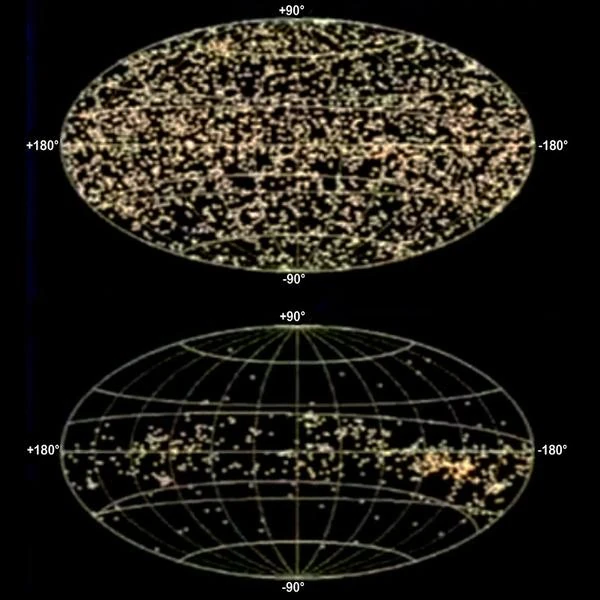
Image description: The Gould Belt is represented at the bottom of the image by stars much more massive than the Sun (7 to 20 solar masses) and younger (<40 million years). This bubble of stars, aged 100 million years, shows all the stars very close to the Sun, at a distance of less than 1500 light-years (data from the Hipparcos satellite from 1989 to 1993). The top image represents the older stars with a mass almost identical to our Sun. The Gould Belt appears as a curved band if we photograph only the stars of the Milky Way located less than 1500 light-years from the Sun, while erasing the small and old stars.
The Gould Belt, named after Benjamin Gould (1824-1896), who identified it in 1879, is a young structure of our Milky Way, aged 100 million years. In reality, it is a "small bubble" with a diameter of 3000 light-years, composed of gas and stars, located in our very close galactic environment, in which the solar system travels.
The Gould Belt is inclined by about 18 degrees relative to the plane of the Milky Way. We live in a spiral galaxy with a diameter of ≈100,000 light-years, but it is very difficult to map its structure because we are inside this structure, which explains the blur on the number of existing arms and even on their naming.
What clearly appears from Earth is the continuous white band of the Milky Way, but this galaxy is actually composed of at least four major spiral arms (Sagittarius arm, Orion arm, Perseus arm, Cygnus arm). Its mass is ≈400 billion solar masses and our Sun rotates at ≈217 km/s, at a distance of ≈27,200 light-years from the galactic center, in the Orion arm. At this speed, it takes ≈240 million years to complete one rotation.
The Gould Belt contains many young and hot stars; it could constitute part of the embryo of the local arm to which the Sun belongs. This small local structure of the Galaxy is our "playground"; it is this ring of molecular clouds and bright young stars that hides the background of the Milky Way from us. This region forms a bright bar in front of the Milky Way, visible especially from the southern hemisphere. This bar is inclined relative to the Milky Way, giving the Milky Way a curved shape.
When we look at the Milky Way, we mainly see a band inclined relative to the galactic plane because the stars close to the Sun are very bright. The Gould Belt thus draws a large curve on the Milky Way, where many very active stars are forming.
The Hipparcos satellite (HIgh Precision PARallax COllecting Satellite) of the European Space Agency operated from 1989 to 1993. For 4 years, it measured the position, parallax, and proper motion of the stars in our Galaxy. The data from Hipparcos allowed for this simulation (right image) highlighting the Gould Belt.
The Gould Belt appears distinctly if we photograph only the stars of the Milky Way located less than 1500 light-years from the Sun, while erasing the small and old stars.
In the top image, we see a homogeneous distribution of all the stars close to less than 500 parsecs (<1500 light-years), whose mass is roughly equal to that of our Sun (if we photographed all the stars, near and far, we would see the Milky Way drawn over it). We kept the stars of type A and F, almost as massive as our Sun, rather old, and in the bottom image, we kept the stars of type O and B, much more massive than the Sun (7 to 20 solar masses) and of course, younger, less than 40 million years old. The brightest stars of the Gould Belt are distributed over a curved band relative to the Milky Way, which is what Benjamin Gould had spotted in the skies of the southern hemisphere in 1879. The Gould Belt is therefore a ring of gas inclined relative to the galactic plane.
Several scenarios are being studied, but it is likely that it was a gigantic hypernova equivalent to 10 supernovae that generated this shock wave that is now sweeping our close environment. This circular shock wave of 240,000 solar masses has probably deformed into an elliptical ring and tilted upwards from the Milky Way, the density of gas being less strong upwards than on the galactic plane.
The entire ring has tilted despite the gravitational force of the stars of the galactic plane tending to bring it back to the plane. This shock wave of ≈1000 light-years has been rocking the interstellar medium of our close environment for a few tens of millions of years.
The Sun is currently crossing this ring, where at the periphery, the star-forming bubbles of the Gould Belt are exploding. The first generations of massive stars have already disappeared in supernovae and have spread their matter in our stellar environment. On the edges of the Gould Belt, there remain about 300 to 400 supernovae that will explode in the next few million years. Statistically, 1 explosion occurs every 40,000 years, and we are in the front row to witness this "stellar fireworks" because we are currently crossing a region particularly rich in supernovae.